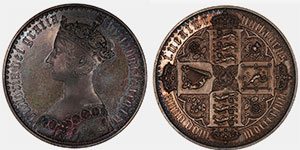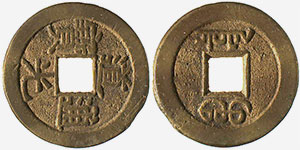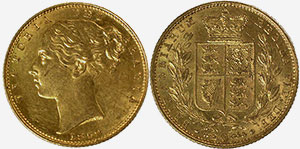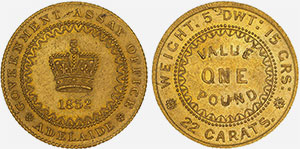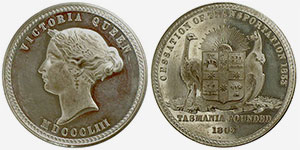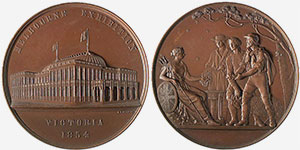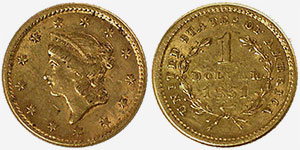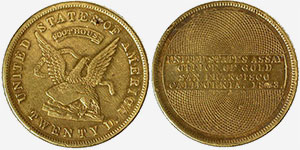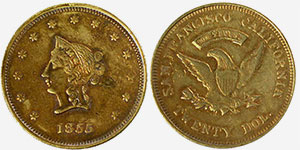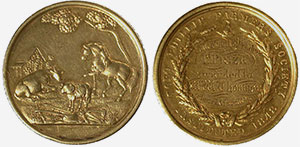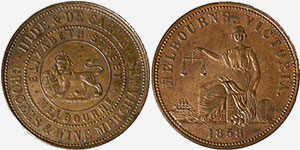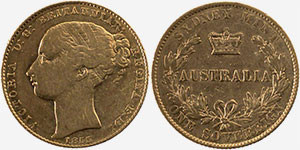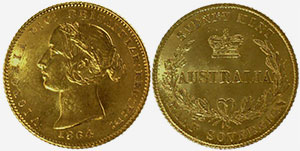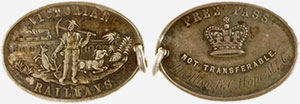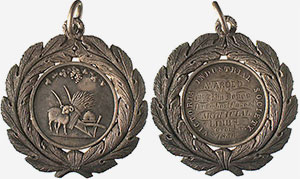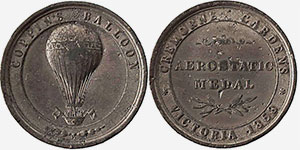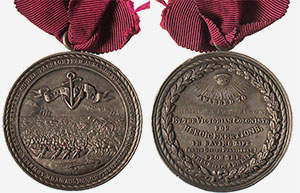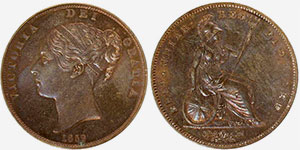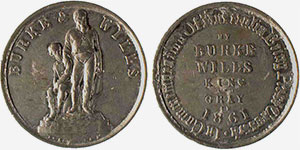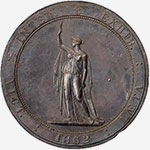1851-1864 - Gold! - Coins and medals - Timeline and pictures
By Museum Victoria | Thursday, 22 November 2007
The discovery of gold in 1851 had an extraordinary impact upon the economic and cultural development of Victoria. Melbourne's population exploded and country towns flourished.
Gothic Crown (five shillings), 1847
This coin bears a portrait of a young Queen Victoria. It is a five shillings denomination and called a crown. Because of the style of the lettering this coin is known as the Gothic Crown. It was acquired by the Melbourne Mint to exhibit at the 1880 Melbourne International Exhibition.
During this period, local merchants had to make their own small change. This is an example of the hundreds of varieties made in Victoria.
Obverse - Crowned bust of Queen Victoria facing left. Around it in Gothic script is the Latin legend Victoria Dei gratia britannia f:D: [Victoria by the Grace of God Queen of Great Britain, Defender of the Faith].
Reverse - Arms of England, Scotland and Ireland forming a cross with roses, shamrock and thistle in angles. Around the Arms in Gothic script is the Latin legend tuetur unita deus anno dom. Mdcccxlvii [May God guard these united kingdoms 1847 AD].
Chinese 'cash' coin, 1851
This type of coin, cast in brass with a square hole at the centre, were the standard type coin of China for thousands of years. They were copied in Korea, Japan and Vietnam. Chinese merchants took them throughout Asia and to Australia during the gold rush era. They are commonly found on the Victorian goldfields and turn up regularly in archaeological excavations in Melbourne's Chinatown district.
Obverse - The Chinese legend Tao-kuang T'ung-pao around a square hole. This is a coin of the sixth Ch'ing emperor, Hsuan Tsung. Coins of this type are commonly called 'cash'. They were cast with this legend from 1821 until 1851.
Reverse - Manchu legend for the mint of the Board of Revenue in Beijing.
Sovereign, 1852
This is an example of the famed gold sovereign. It was struck in London in 1852, perhaps from gold sent from the new discoveries in Australia. This coin may even have been brought to Australia by someone taking part in the gold rush. This sovereign design is commonly known as the shield type. The design was later used at both the Sydney and Melbourne Mints, being distinguished from the London coins only by the addition of a tiny letter S or M under the bow at the base of the wreath.
Obverse - Head of a young Queen Victoria and the date 1852. Around the head is the Latin legend VICTORIA DEI GRATIA [Victoria by the grace of God]. On the Queen's neck are the letters W.W., the initials of the artist William Wyon.
Reverse - Within a wreath of olive branches, the crowned arms of Great Britain. Below the wreath is a rose, shamrock and thistle. Continuing from the obverse is the Latin legend BRITANNIARUM REGINA FID: DEF: [Queen of the Britons, defender of the faith].
The Adelaide Pound, 1852
This was not really a coin, but a coin-shaped ingot guaranteed to be worth a pound. The Colony of South Australia backed their valuation by giving exact details of the purity (22 carats) and weight (5 pennyweight and 15 grains) of the piece. It was made from gold brought to South Australia from the Victorian goldfields in 1852. Although production was technically illegal, these pieces were made by the South Australian government to solve a major problem in the local economy caused by people leaving for the gold fields and taking most of the colony's money with them. By the time the written request for authority to make the pieces had arrived in England and the refusal returned to Adelaide, the Assay Office had opened, solved the problem by issuing the tokens and closed.
Obverse - At the centre is a crown above the date 1852. Around it is the legend GOVERNMENT ASSAY OFFICE ADELAIDE.
Reverse - At the centre is the legend VALUE ONE POUND and around it, WEIGHT 5 DWT: 15 GRS: 22 CARATS.
Cessation of Transportation medal, 1853
This medal was struck to commemorate the end of transportation of convicts to Tasmania in 1853. News of the British decision to send no more convicts first reached Tasmania via Melbourne. It came from London on the steamer Harbinger and transferred to Launceston on the Yarra Yarra. At celebrations in Tasmania, children were given a piece of Demonstration Cake and a ticket entitling them to a medal. Nine thousand white metal medals were struck and an additional 100 were produced in bronze for members of various committees.
Obverse - Head of a young Queen Victoria with the legend VICTORIA QUEEN above, and below, MDCCCLIII [1853].
Reverse - Shield of arms below a rising sun supported by an emu and a kangaroo. Above the shield is CESSATION OF TRANSPORTATION 1853 and TASMANIA FOUNDED 1803 below.
Melbourne Exhibition prize medal, 1854
This bronze prize medal was awarded to H Davis for a painting exhibited at the Melbourne Exhibition of 1854. The exhibition was organised to select exhibits suitably for representing the colony at the Paris International Exhibition in 1855. The exhibition building was specially constructed and stood at the corner of William and LaTrobe Streets.
Obverse - A view of the exhibition building with MELBOURNE EXHIBITION above and VICTORIA 1854 below. The artist's name, J.S. Wyon of London, can be found just below the right side of the building.
Reverse - A gold miner, a shepherd and a wheat farmer offering their produce to Britannia who is seated at the left. The Southern Cross is visible in the sky.
US gold dollar, 1851
This is a gold one dollar coin from the United States of America dated 1851. Coins such as this were produced during the Californian gold rush to meet an acute need for small denomination coins. The British government was aware of the practice in California and made a special effort to ensure that this did not occur in Australia by both legally forbidding the practice and by establishing Branches of the Royal Mint in Sydney and Melbourne.
Obverse - Head of Liberty facing left, surrounded by 13 stars.
Reverse - At the centre within an olive wreath is the legend 1 DOLLAR 1851; around which is UNITED STATES OF AMERICA.
Gold $20 San Francisco Assay Office, 1853
This coin was deposited with the Melbourne Mint and is thought to have been brought to Australia by an American gold seeker.
Obverse - Eagle standing with wings spread above a plaque with the legend 900THOU (a measure of the gold purity 900 parts per thousand or 90 percent pure), around which is UNITED STATES OF AMERICA TWENTY D.
Reverse - UNITED STATES ASSAY OFFICE OF GOLD SAN FRANCISCO CALIFORNIA 1853 struck with a simple machined background.
Private gold $20 piece California, 1855
This is a privately struck gold token valued at $20 from the Californian gold rush. This example was struck by Wass, Molitor & Co. This coin was deposited with the Melbourne Mint and is thought to have been brought to Australia by an American gold seeker.
Obverse - Head of Liberty facing left with the initials of the producing company W.M. &c.; on her coronet. Liberty is surrounded by 13 stars representing the original US colonies and the date 1855 below.
Reverse - At the centre is an eagle with spread wings and the arms of the USA on a shield. The eagle clasps in its talons a wreath of olive and three arrows, representing peace and war. Above is a plaque inscribed 900 THOUS which denotes the purity of the gold as 900 parts per 1000 (90 percent pure). Around the rim is the legend SAN FRANCISCO CALIFORNIA and the denomination TWENTY DOL.
Gisborne Show medal, 1859
This is a gold prize medal awarded by the Port Phillip Farmers Society to Mr. W. Thomson at the Gisborne Show in 1859.
Obverse - A farming scene featuring a cow, horse, sheep, tools and in the background a small farmhouse with a grapevine growing on the wall.
Reverse - Below a small kangaroo and within a wreath of wheat is the inscription Collection Agl. Produce 1st. Prize awarded to Mr. W. Thomson Gisborne Exhibition 1859. Around the inscription is the legend PORT PHILLIP FARMERS SOCIETY INSTITUTED 1848.
Hide & DeCarle penny token, 1858
Tokens were privately produced and circulated as unofficial coins. Because of a shortage of official currency, they were used in Victoria between 1849 and 1862. This one was circulated as a penny denomination by the grocery firm Hide and DeCarle, which issued penny and halfpenny tokens in 1857 and 1858. They were manufactured in England and were the same size as the legal tender coins of the period.
Obverse - At the centre is a crowned lion holding a shield bearing the Union Jack. Around this in two rings is the legend HIDE & DE CARLE GROCERS & WINE MERCHANTS ELIZABETH STREET MELBOURNE.
Reverse - A figure of Justice seated on bales and barrels, blindfolded and holding a set of scales in her right hand. In her left hand an inverted cornucopia spills fruit on the ground. In the background is a sailing ship. Above is the legend MELBOURNE, VICTORIA and 1858 is below.
Sydney Mint gold coins, 1855 - 1856
These coins are a gold sovereign and half sovereign struck at the new Sydney Mint in its first two years of operation, 1855 to 1856. Although these coins should have been current throughout Australasia from 1855, the necessary proclamation by the Governor of Victoria was not issued until 1857 - by which time they had already been proclaimed current in Hong Kong, Sri Lanka and Mauritius!
Obverse - Head of Queen Victoria facing left. Around the head is the Latin legend VICTORIA D:G: BRITANNIAR: REGINA F:D: 1855 [Victoria, by the grace of God Queen of the Britons, Defender of the Faith 1855].
Reverse - Below a crown is a wreath of olive branches surrounding the word AUSTRALIA around which is the legend SYDNEY MINT ONE SOVEREIGN.
Sydney Mint gold coins, 1857 - 1870
These coins are a gold Sovereign and Half Sovereign of the second Sydney Mint design. The new portrait of Queen Victoria by the artist L.C. Wyon was introduced in 1857 and remained in use until 1866 on the half sovereign and 1870 on the sovereign.
Obverse - Head of Queen Victoria facing left, with plaited hair looped below her ear. Around the head is the Latin VICTORIA D:G: BRITANNIAR: REGINA F:D: 1857 [Victoria, by the grace of God Queen of the Britons, Defender of the Faith 1857].
Reverse - Below a crown is a wreath of olive branches surrounding the word AUSTRALIA around which is the legend SYDNEY MINT ONE SOVEREIGN.
Parliamentary Rail Pass, 1856
This is a Victorian Railways Parliamentary Pass issued to the Hon. RC Hope MLC. Robert Hope was born in Scotland, migrated to Sydney in 1838 and travelled overland to the Port Phillip District in 1847. He was elected to the Legislative Council in 1856.
Obverse - The words VICTORIAN RAILWAYS together with gold miner with pick slung over his shoulder standing in front of a railway viaduct on which a steam train is travelling. A small kangaroo and large sheep rest in the mid-field.
Reverse - A crown at the centre, with the words FREE PASS NOT TRANSFERABLE above and below. It is inscribed The Hon. R.C.Hope M.L.C.
Industrial Exhibition medal, 1856
This silver prize medal was awarded at the Victorian Industrial Exhibition of 1856. This medal was won by John Jones for his entry of artificial limbs.
Obverse - A grapevine above a sheep, sheaf of wheat, plough and bee hive.
Reverse - The legend VICTORIA INDUSTRIAL SOCIETY AWARDED TO is around the inscription Mr. John Jones for the best Case of ARTIFICIAL LIMBS November 1856.
Coppin's Balloon medal, 1858
This is a commemorative medal thought to have been sold as a memento to people who viewed the public ascent of George Coppin's balloon from the Cremorne Gardens. Coppin had purchased his balloon on a visit to England and hired two "daring Aeronauts", Dean and Brown, to make tethered flights three times a week.
Obverse - At the centre is a balloon with aeronauts Dean and Brown in the basket. Above it on a broad rim is COPPIN'S BALLOON.
Reverse - The legend CREMORNE GARDENS AEROSTATIC MEDAL * VICTORIA 1858 *.
Admella shipwreck medal, 1859
This medal is the Admella shipwreck bravery award. Medals were awarded to each of the 88 people involved in rescue attempts after the steamer Admella hit a reef during a storm and broke in two. Although the wreck was close to land, severe weather conditions meant that a week passed before the last of the 24 survivors (out of 114) could be rescued.
Obverse - Scene at the wreck site as rescuers attempt to launch their boats into heavy seas. The wrecked Admella lies just beyond the breaking waves. Other steamers stand off at sea unable to assist. Above on a ribbon wrapped around an anchor is the legend HOPE TO THE LAST. Around it is ADMELLA STEAMER WRECKED ON HER PASSAGE FROM ADELAIDE TO MELBOURNE OFF CAPE NORTHUMBERLAND (6 AUG. 1859).
Reverse - Within a wreath and beneath the All Seeing Eye is AWARDED TO CHARLES PATTERSON BY THE VICTORIAN COLONISTS FOR HEROIC EXERTIONS IN SAVING LIFE (UNDER DIVINE PROVIDENCE) FROM THE WRECK OF THE ADMELLA.
The new bronze penny, 1860
In 1859 the British struck their last copper pennies, halfpennies and farthings. From 1860 new smaller bronze coins were struck for these denominations. This new smaller size remained in use into the 20th century and became the model for Australian penny and halfpenny coins until 1964. The full Latin legend from both sides of the copper coin was placed on the head of the smaller bronze penny. The date was then taken from under the Queen's head and placed on the back, under the figure of Britannia. The denomination ONE PENNY was added to avoid confusion that it was an old copper halfpenny.
Obverse - On the copper coin head of Queen Victoria facing left, below which it the date 1859. Around the head in Latin is VICTORIA DEI GRATIA [Victoria by the Grace of God]. On the bronze coin is a bust of Queen Victoria reaching to the edge of the coin. Around it in abbreviated Latin is VICTORIA D:G: BRITT: REG: F: D: [Victoria by the Grace of God, Queen of the Britons Defender of the Faith].
Reverse - On the copper coin is Britannia seated facing right, holding a trident and a shield bearing the Union Jack. Around Britannia is the Latin legend BRITANNIAR: REG: FID: DEF: [Queen of the Britons, Defender of the Faith].
Burke and Wills medal, 1861
This is a medal struck to commemorate the ill-fated Burke and Wills expedition. Although they succeeded in crossing Australia from south to north, all members of the expedition perished on the return journey.
Obverse - Figures of Robert O'Hara Burke and William John Wills, and around them the inscription BURKE & WILLS.
Reverse - The legend IN COMMEMORATION OF AUSTRALIA BEING FIRST CROSSED BY BURKE WILLS KING GRAY IN 1861.
Exhibition Seal, 1862
This is a thin one-sided medal or pressing of an official seal for the 1862 exhibition by the artist Charles Summers. It depicts the personification of the colony of Victoria as a classical goddess holding aloft a torch. The history of this piece is unclear. It probably relates to the Victorian entries in the London International Exhibition of 1862.
Obverse - The goddess representing the Colony of Victoria standing looking left and holding aloft a torch. Around her is the Latin legend INTER. EXHIB. VICT. 1862 LAETA [Inter (national?) Exhibition 1862, Victoria the fertile].

